![]() Também disponível em Português por Mathias Luz
Também disponível em Português por Mathias Luz
 One of the most powerful concepts I’ve ever come across in business is the idea of the customer’s Desired Outcome.
One of the most powerful concepts I’ve ever come across in business is the idea of the customer’s Desired Outcome.
And if you’re thinking “one of the most powerful concepts in business” seems like a pretty hefty charge, you’re right; this concept has transformational properties.
When I first introduced Desired Outcome, I explained that this idea came about as a simple replacement for “what does Success mean to your customer?”
But it’s SO MUCH MORE than that… let’s dig in.
Quick Refresher on Definition of Customer Success
First, remember that when your customers achieve their Desired Outcome through their interactions with your company, that is customer success.
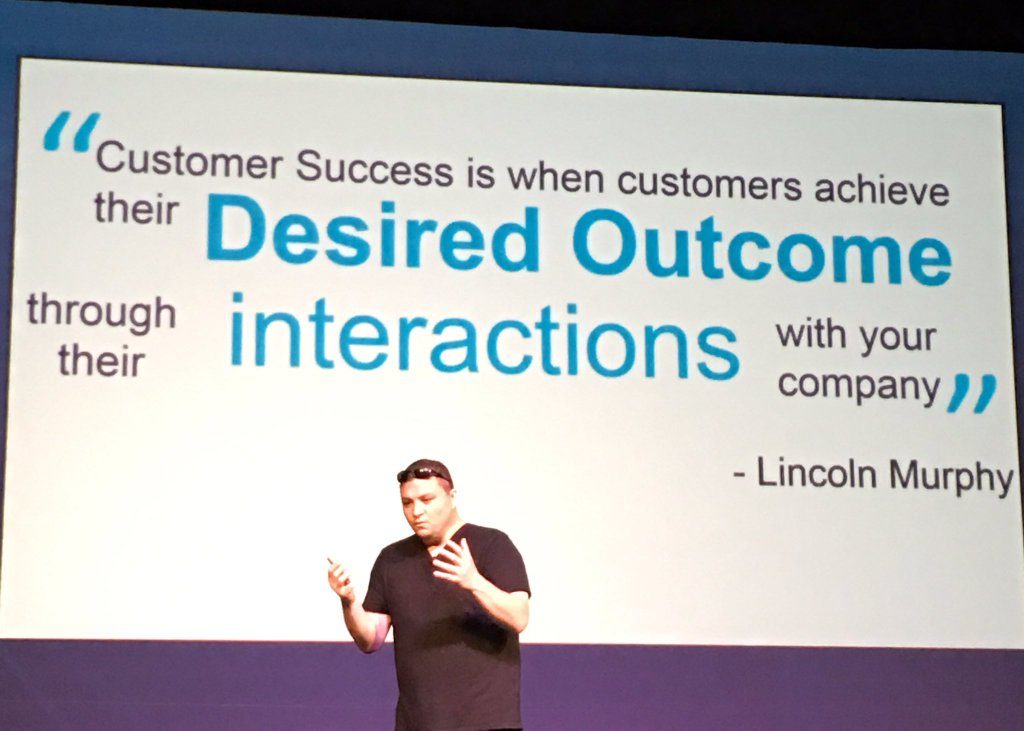
And the process used to proactively ensure your customers achieve their – or to orchestrate – Desired Outcome, is what we call Customer Success Management. That is both a function within an organization and software product category.
Read my Definitive Guide to Customer Success for a great primer on this concept if it’s new you.
you can focus on adoption, retention, expansion, or advocacy; or you can focus on the customers' Desired Outcome and get all of those things
— Lincoln Murphy (@lincolnmurphy) April 11, 2016
Desired Outcome has Two Parts
The two parts of Desired Outcome are: Required Outcome and Appropriate Experience
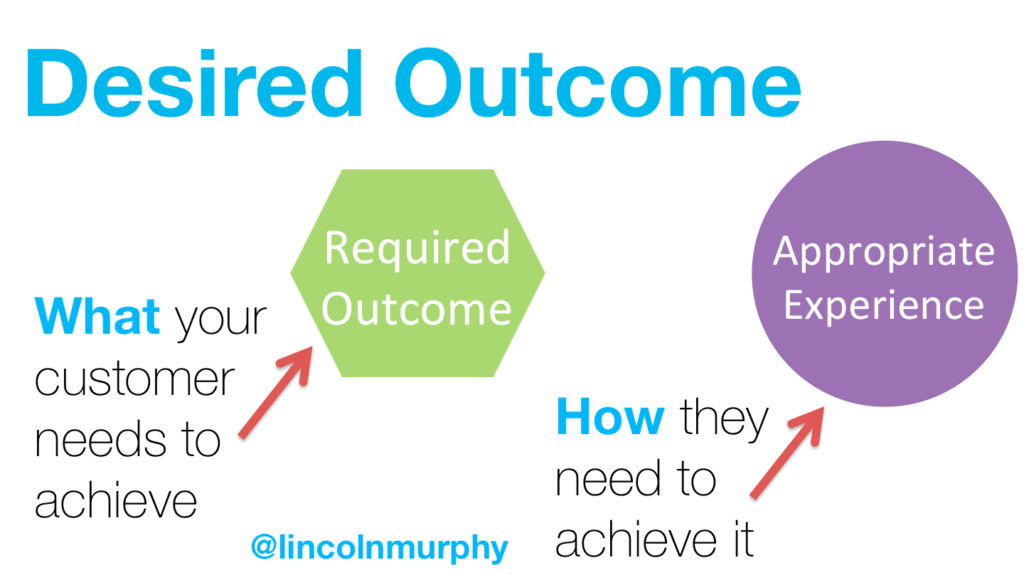
In the original article on Desired Outcome, I went into detail on how to think about the two parts, but as I’ve been traveling around the world and sharing this concept with my clients and at conferences, I could tell there was still a disconnect.
But it was a few years ago at a private event in Toronto that I keynoted and facilitated a workshop that I finally hit on how to best describe the two parts of Desired Outcome… and I want to share it with you.
Desired Outcome is what the customer needs to achieve (Required Outcome) and how they need to achieve it (Appropriate Experience)
— Lincoln Murphy (@lincolnmurphy) May 14, 2016
This is so awesome… here we go.
First Part: Required Outcome (RO)
Required Outcome (RO) is the thing your customer needs to achieve, the thing they are trying to accomplish; helping them achieve that is why you exist in their world.
Helping them achieve their Required Outcome is what gets you in the game. If you can’t help them achieve their Required Outcome, that’s a non-starter.
Desired Outcome > Job to be Done
— Lincoln Murphy (@lincolnmurphy) May 4, 2016
But let me be very clear; Required Outcome is NOT the functional use of your product. It is NOT the Job to Be Done. The Required Outcome is an outcome that matters – often deeply and even emotionally – to the customer.
For bigger or more complex customers, this may matter in different ways to the various personas within the customer account.

Required Outcome Example: Event Promotion
The example I always like to give – because I think we can all wrap our brains around this even if we are never in this situation – is when an event organizer needs to get more people to signup for their event; that’s their Required Outcome.
The thing is, there are many different ways to achieve that Required Outcome.
They could print fliers about the event and hand them out on the street, they could run ads on Facebook, they could create content on the subject the event will cover and use inbound techniques to attract potential attendees to read that content and, hopefully, signup to attend the event.
But, since this event organizer already has a list of email addresses, for the sake of this example, they’re going to choose email marketing as a way to achieve their Required Outcome.
As a SaaS vendor, remember that it could be a commercial SaaS or on-prem software competitor, open source software, DIY project, or manual labor that could be the alternative method the customer could use to achieve their Required Outcome.
The thing the customer needs to get done can be achieved in myriad ways; it’s good to keep this in mind if for no other reason than to keep your ego in check.
Now, the email marketing software vendor the customer chose in this example needs to know – and keep top of mind – that the customer didn’t choose to do business with them because they want to send emails; they chose to do business with them because they need to achieve their Required Outcome… they need to get more people to attend their event.
Remember, the customer believes, because of your marketing materials or what they learned from your salesperson (or both) that you can help them achieve their Required Outcome.
They also believe that you’ll help them achieve their Required Outcome in a way that is appropriate for them, which is why they chose you over your direct, analogous competitors.
Let’s explore that part…
Second Part: Appropriate Experience (AX)
Required Outcome – no offense to it – is really nothing without Appropriate Experience (AX).
For long-term success – yours and the customers’ – you need to not just help your customers achieve their Required Outcome, but you need to help them do that in a way that is appropriate for them.
And yes, every customer segment (for every product you have!) will have a different experience that is appropriate for them.
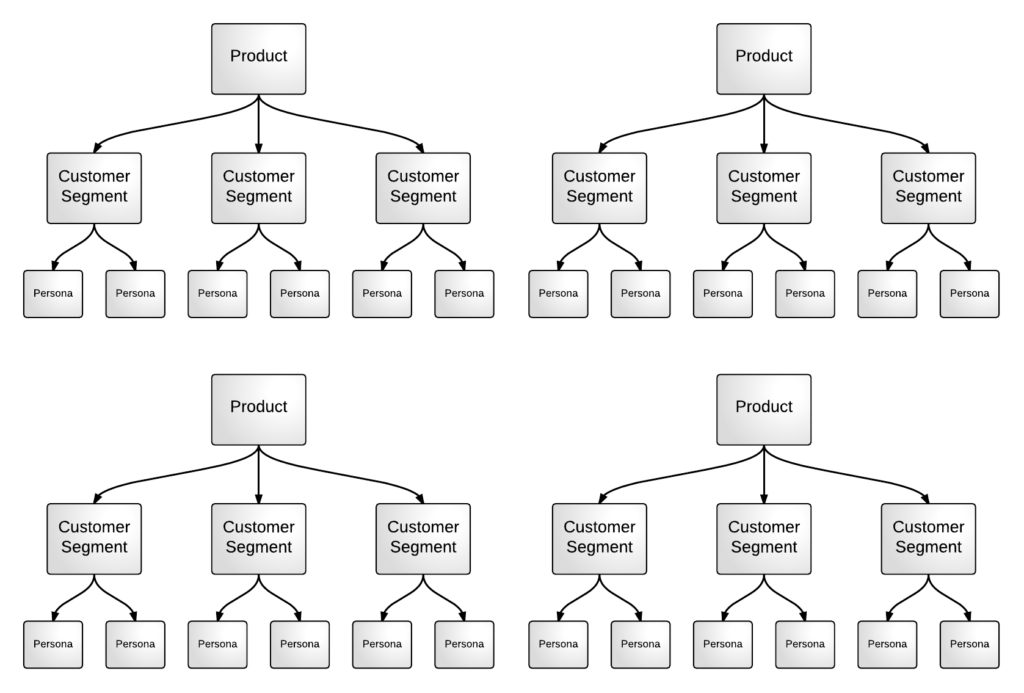
That may give you pause as it presents a significant amount of work; that pause is fine, just don’t let it stop you… keep moving forward, it’s totally worth it!
Look, anyone can slap together some features and functionality that could help someone achieve their Required Outcome and call it a “product” (and many do!)… but if it doesn’t help your customer achieve that Required Outcome in the right way – the way THEY want or need to achieve it – then you failed to deliver the appropriate experience and the customer won’t see the experience as one that was successful. Even if they achieved their Required Outcome!
It may seem a bit counter-intuitive, but it happens all the time… it’s likely happened to you.
The perception of an Appropriate Experience is why your customers buy your product and not your competitors. It’s why they decided to do business with you vs. your competitors or, frankly, any of the other ways they could have achieved their Required Outcome.
Appropriate Experience is your differentiator; it’s why you exist. It’s why customers choose you over the next best alternative.
Appropriate Experience is – BTW – just that; appropriate.
That’s why I don’t say you need to provide an Awesome, Modern, High-Touch, or Rich experience… only what’s appropriate.if you’re selling to tech startups, you might be okay launching with just an API.
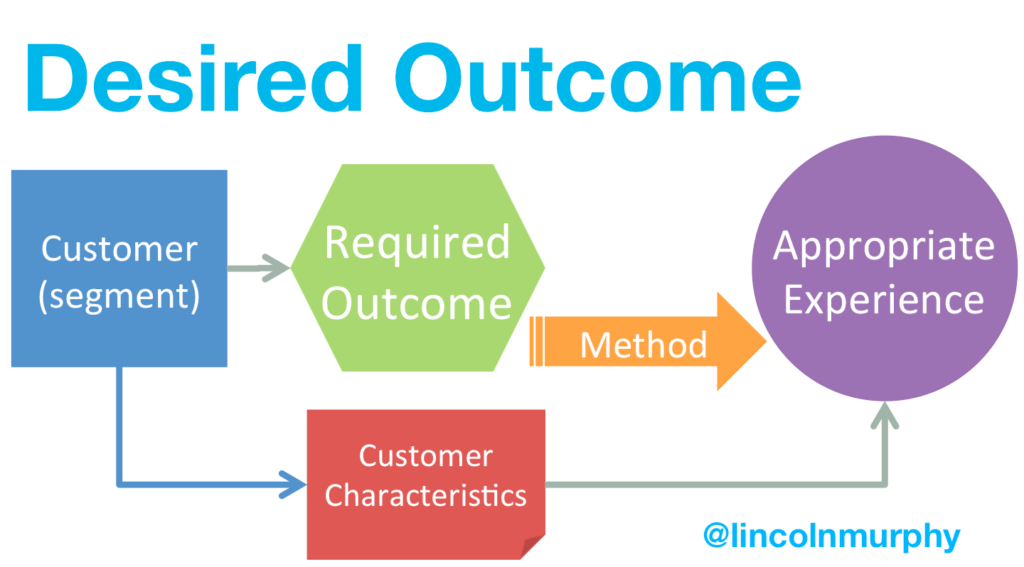
As you move beyond early adopters, you may need to build a UI and offer 24/7 support to provide that new cohort of customers the appropriate experience.
And you may sell to both of those customer segments at the same time!
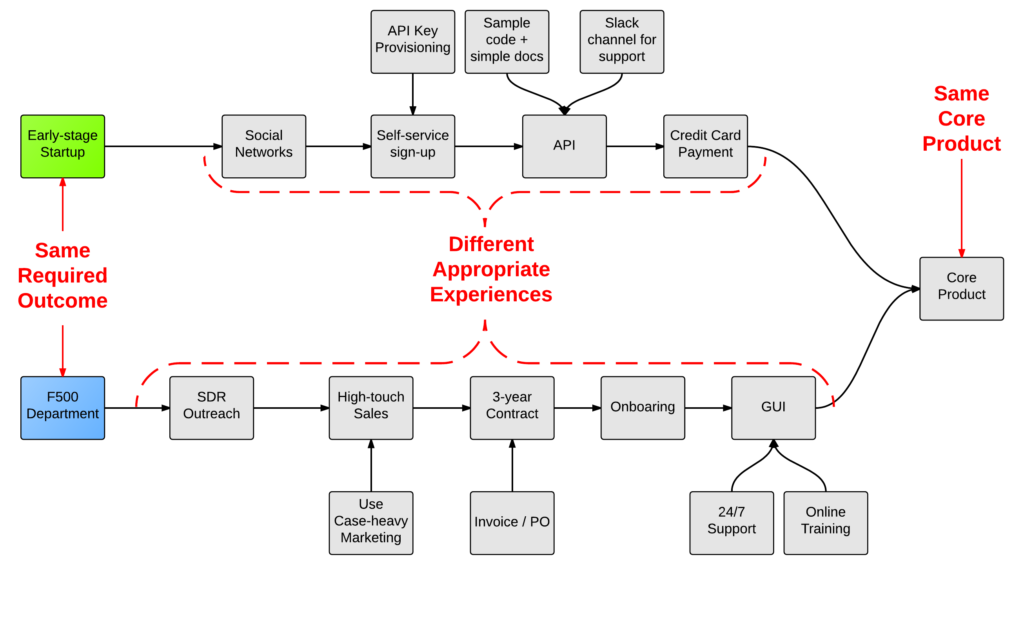
But if you try to sell one the experience that works for the other, or worse if you try to normalize an experience that “works for everyone,” you’re going to end up failing to deliver the appropriate experience to some segment(s) of customers.
And just to be clear; Appropriate Experience isn’t only about your product.
Appropriate Experience encompasses every interaction your customer has with your company; that includes your sales, marketing, thought leadership, onboarding, professional services, support, customer success management, ecosystem, and yes, your product.
That’s why I say “through their interactions with your company” in the definition of Customer Success, rather than “through your product.”
Learn more about the process of discovering the Appropriate Experience for your customers here.
Desired Outcome is the Secret to Success
you can focus on adoption, retention, expansion, or advocacy; or you can focus on the customers' Desired Outcome and get all of those things
— Lincoln Murphy (@lincolnmurphy) April 11, 2016
As I mentioned earlier, one of the really interesting things about Desired Outcome – and why it’s so powerful – is that if you only help the customer achieve the Required Outcome, they may not feel “successful.”
That’s the opposite of what we tend to think, but it’s true.
A great example of this is when I exit a Southwest Airlines flight and complain to myself as I walk down the jet bridge to the terminal about the horrible experience; cramped seats, no wifi, and no assigned seating so I couldn’t get any work done.
Obviously, they met my Required Outcome – get me from Point A to Point B quickly and safely – because I’m alive and able to complain, but otherwise I 100% of the time don’t feel like flying on Southwest was “successful.” For me.
But I’m not the Ideal Customer for Southwest… the person exiting the plane behind me who is going on a vacation and was looking to save money in the process may feel like it was a great experience and wonder why I look so unhappy and mumbling swear words to myself. That person is their Ideal Customer.
To bring it back to the SaaS world, if you use a “bare bones” app that someone hacked together quickly that “gets the job done” but the UX is pretty rough and there’s no support or documentation and you have to work hard just to figure out how to use it, do you feel successful? Do you want to continue to use it? Are you going to invest your political capital into introducing this product into other parts of your company? Are you going to tell the world they should use it, too? No. No. No. And no.
So, even though you technically achieved your Required Outcome using that product, something was missing and you want to find a different solution. That something that was missing is the Appropriate Experience.
And if you’re the SaaS vendor, it’s up to you to understand the customers’ Desired Outcome better than they understand it themselves and provide an experience that’s so appropriate – so on point – that they don’t even notice it.
Now, when you mix Desired Outcome with a well-designed Ideal Customer Profile… you’ve got Growth Rocket Fuel!



